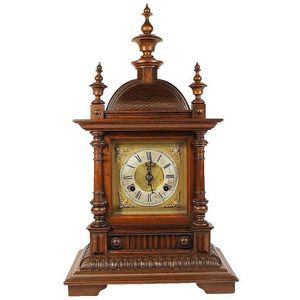Beha Black Forest Bracket Clock with Cuckoo and Figures
You must be a subscriber, and be logged in to view price and dealer details.
Subscribe Now to view actual auction price for this item
When you subscribe, you have the option of setting the currency in which to display prices to $Au, $US, $NZ or Stg.
- Oak - Native to Europe and England, oak has been used for joinery, furniture and building since the beginning of the medieval civilisation. It is a pale yellow in colour when freshly cut and darkens with age to a mid brown colour.
Oak as a furniture timber was superceded by walnut in the 17th century, and in the 18th century by mahogany,
Semi-fossilised bog oak is black in colour, and is found in peat bogs where the trees have fallen and been preserved from decay by the bog. It is used for jewellery and small carved trinkets.
Pollard oak is taken from an oak that has been regularly pollarded, that is the upper branches have been removed at the top of the trunk, result that new branches would appear, and over time the top would become ball-like. . When harvested and sawn, the timber displays a continuous surface of knotty circles. The timber was scarce and expensive and was used in more expensive pieces of furniture in the Regency and Victorian periods. - Circa - A Latin term meaning 'about', often used in the antique trade to give an approximate date for the piece, usually considered to be five years on either side of the circa year. Thus, circa 1900 means the piece was made about 1900, probably between 1895 and 1905. The expression is sometimes abbreviated to c.1900.
- Movement - The technical name for the workings of a clock or watch, and does not include the dial or case.
This item has been included into following indexes:
Visually similar items

A George III style mahogany longcase clock the eight day movement with an anchor escapement, gong striking, with a silvered dial and subsidiaries for seconds, month and moon phase, housed within a mahogany case, 255 cm high

German walnut mantle clock with a fish scale carved roof and timber turned finials. Has both a key and pendulum. Height 50 cm

A Vienna twin weight and regulator wall clock, circa 1880, within a walnut case the circular two piece enamel dial enclosed behind glazed shaped door flanked by carved columns and surmounted by architrave carved top, 47 cm width x 18.5 cm depth x 122 cm he

An impressive architectural style Victorian bracket clock late 19th century, mahogany, likely Scottish, having a triple fusee musical movement, with bell striker dial with silent and chiming settings and with musical chimes, Whittington and Westminster. Th
